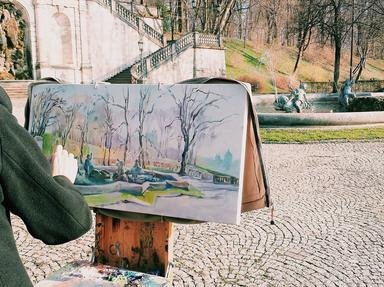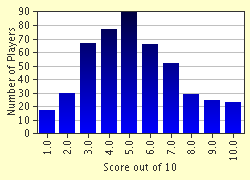Quiz Answer Key and Fun Facts
1. One of my favorite paintings is of the Biblical "Samson and Delilah." Created in 1609, this masterpiece in oil on wood shows the detail of the artist's hand. Upon looking at the painting, to the far right-hand in the background, you will notice a man that is watching the conniving Delilah as she is becoming anxious for the barber to strip Samson of his strength-holding tresses. This is an excellent example of the artist capturing minute expressions outside the reach of vision. If one only looks at Samson and Delilah, then you are sure to miss the statue of mother and child which adorns the wall behind the barber. Who is the creator of this magnificent work of art?
2. Another painting that is a favorite, and expresses the still life aspect of creation, is "Apples, Peaches, Pears and Grapes," which was done in oil on canvas and was created between 1879 to 1880. The use of dark spaces and shadowing underneath the table, and the background view and exposure of what appear to be leaves on a vine hanging in mid-air, show that the artist is an expert with stills. By using geometric and dimensional shapes the fruit that is placed on the platter in the center of the table, is brought to life. Who is the creator of this work of art?
3. This is another favorite of mine, which stems from learning about Greek Mythology in school. I had a wonderful teacher who made certain that his students knew full well "The Myth of Prometheus." This painting is perhaps my most favorite, although I have many. This painting was created in 1515 in oil on panel, which perhaps may explain its captivating nature. The attention to the detail in the distance of the clouds is truly remarkable; if you pay close attention it appears as if someone is watching Prometheus from above. The main focal point in the creator's mind is of a man, with his arm raised and pointing towards the right. Following his finger you can clearly see a couple flying in the skies above, and they seem to be rejoicing in the gift that Prometheus has given to them; others have a severe look of distress as if they are expecting the pending doom that is bound to happen. The waves of the hillside beyond the painter's attention is noticeable, yet does not detract from the man standing on his pedestal, and one can picture in one's mind the people that live there. Who created this mythological painting?
4. Onward and upward with the ever continuing list of paintings that capture my attention. In 1533, "The Ambassadors" was created in oil on wood. This astounding masterpiece portrays the images of Jean de Dinteville, the French Ambassador to England during 1533 and of Georges de Selve, Bishop of Lavaur. The artist's intensity can be seen in the color scheme he chose. The hues of red, which appear as ochre, in contrast to the dark back drop, are noticeable in the vanity that is between the two gentlemen. If you allow your eyes to wander down to the books that are located in the lower portion of the table, you can see that the pages appear life-like, as if they are just waiting to be read or to reveal secrets that these two men may have. Which of the following artists created this painting?
5. To some this next painting may not be so grand or breathtaking, but to me it is a lovely fresh approach to the country scenery. "Field with Poppies" was created in 1889 in oil on canvas. This is a still of a field, and if you look further into the background you can see what appear to be rows that have been hoed, just waiting for someone to sprinkle seeds. The golden hues that are used in the small patch of field to the left, next to the poppies, is a wonderful color scheme. The artist gives you the impression that the trees on the outer edges are swaying. From this writer's point of view, it also gives the vision as if you are standing on a small hillside overlooking the beautiful field. Which artist created this painting?
6. Another one of my favorites is "The School of Athens," which was created between 1510-1511 and is a fresco. The extraordinary attention to the detail in this painting can clearly be seen in every aspect. One should note the many philosophers who abound in the playground set by the artist. Take notice of Pythagoras who can be seen sitting on the lower steps and reading a book to Anaxagoras...the writing in the book is extremely visible, and the gentle look on his face as he is reading to her, is a gift given to him by the fresco's creator. In the main entrance of the painting are two well known and respected philosophers, Plato on the left and Aristotle on the right. Each and every person in the painting has a personality and depth all their own courtesy of the artist. This masterpiece has one amazing interest for anyone that likes this artist's work...he has incorporated himself into the painting, and is situated between Zoroaster and Ptolemy on the far right. Which of the following created this masterpiece?
7. Another one that catches my attention is "The Turkish Bath," which was created in 1862 and is in oil on wood. One of the reasons I like this particular painting is that it shows the artist's impressions of people relaxing and enjoying themselves. Another thing that is not noticeable if you are not looking for it, is a vase that rests in a small alcove on the wall to the left. The fine detail is stunning and gives the impression of being three dimensional. Take note of the lady standing to the left with her arms uplifted...the necklace that she is wearing stands out against her nudity, as if the creator wants attention drawn to her face and not to her body. Which of the following created this painting?
8. "The Biglin Brothers Racing" was created in 1873. One of the reasons that I like this particular painting is quite possibly due in part to the artist's birth place. In "The Biglin Brothers Racing", the unique way the artist has of capturing the rippling of the water, while the brothers are gliding across the surface is mesmerizing. If you dare look further beyond to the shore line, you will note a lovely etched house that has all the features of a seaside and/or country home. But, the most fascinating feature of the painting itself is the simulation of motion that can be seen in the brothers' arms as they are rowing their canoes. Which artist created this painting?
9. Most likely for anyone that enjoys art, "The Last Supper" is on their list of pieces that they like. This mural was created in 1498, and makes note of Jesus' final supper with his apostles. This artist leaves nothing to chance in his version of what transpired during their final meeting. The relaxed and carefree way of his disciples is extremely apparent. One should take notice of the view that is visible from the windows behind Christ: you can clearly see the detail of bushes and trees outside. The fine attention to the garments that are worn by Christ are superbly handled with a slight turn of the brush here and there, bringing the cascading cover to life. One should also note the layout of the eating ware on the table set before them; every single piece is finely detailed right down to the wine in their cups. What is the name of the artist who created this masterpiece?
10. And now we come to the end of my favorite paintings. "Morning" was created in 1821 in oil on canvas. The view that the artist allows us to see is simply amazing. The way it is set you can almost imagine yourself awaking on a crisp morning as the sun beams begin to burst through a shroud of trees and hills. The creator's attention to the rolling fog that covers the ground and enhances the beauty of the trees, yet allows you to see the ever-changing colors of the sky above is most appealing and extremely calming. Looking further at the smaller shrub to the bottom left, you will note the individual attention that was given to every single leaf. Which of the following created this painting?
Source: Author
JuniorTheJaws
This quiz was reviewed by FunTrivia editor
Bruyere before going online.
Any errors found in FunTrivia content are routinely corrected through our feedback system.

